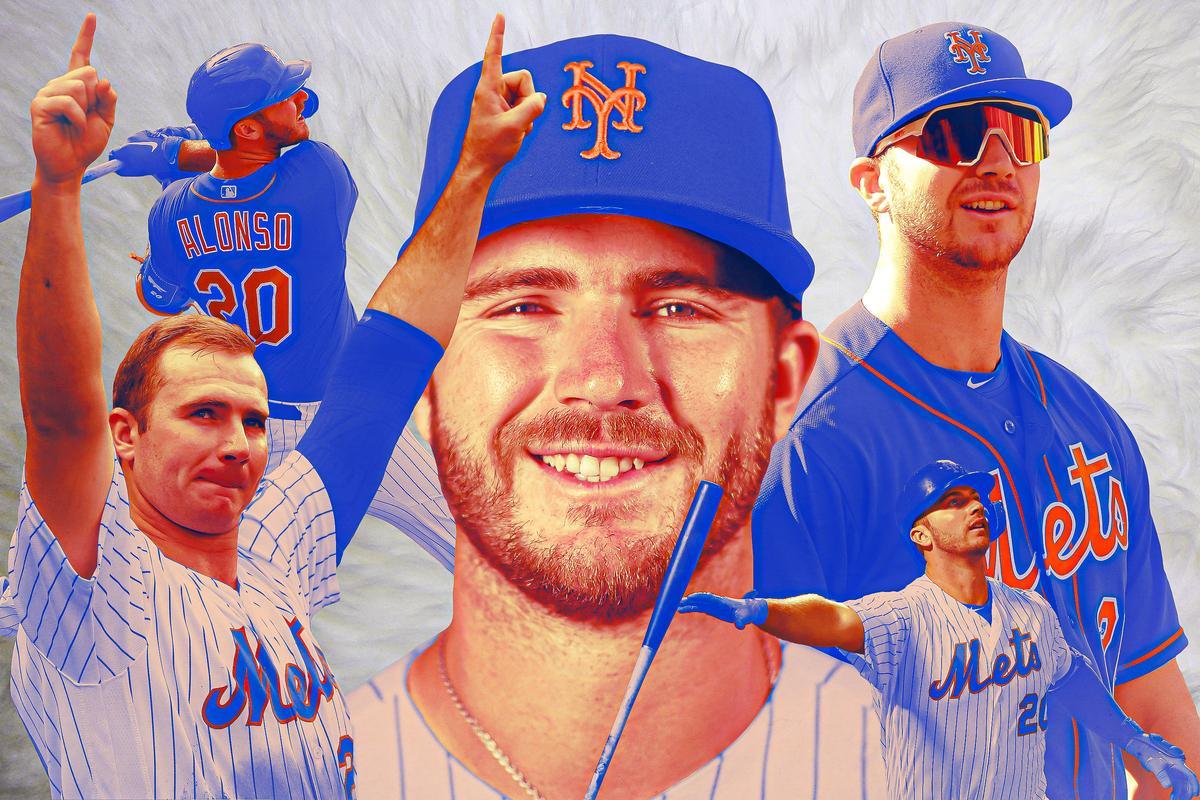
While one of Major League Baseball’s most exciting young talents was busy chasing a rookie home run record and rising to immediate stardom in New York City and beyond, Pete Alonso was down in the minor leagues, taking notes. The year was 2017, and Yankees outfielder Aaron Judge was in the midst of a gangbusters 52-dinger debut season up in the Bronx. “When he was going off I was in the Florida League,” recalled Alonso, the Mets’ prized second-year slugger, speaking on a Zoom press conference with reporters on a recent Tuesday afternoon in July, his mask pulled down around his scruffy chin as he chatted through the computer screen. “It was like, man, this guy came fresh from the minors. And if he could do it, then he’s kind of paving the way for guys like me to come in and make an immediate impact.”
Two years later, during his own MLB rookie campaign out in Queens last summer, Alonso followed in the footsteps of his crosstown colleague Judge (or, as Alonso referred to him, “the guy across the street”). And then he kept going.
Over the course of last season, Alonso hit home runs that landed 474 feet away from him, and he hit home runs that made an actual splash. He hit home runs that left his bat at 118 miles per hour, and he hit home runs despite (because of?) an at-times extremely chill swing that could sometimes resemble a guy idly pantomiming a chip shot in his buddy’s basement. He hit home runs that won the Home Run Derby, which he competed in with a bat named “Haley’s Comet,” after his fiancée. And in late September, he hit home run no. 53 to set a new MLB rookie record.
Alonso’s call-up to the Mets from the minors was not even assured last year during spring training, but in his unforgettable rookie season, Alonso more than proved that he belonged in the big leagues, winning 29 of 30 votes for NL Rookie of the Year. What made him stand out most, though, was just how unafraid he was to act like a kid out there.
He disrobed himself and his teammates. He gallivanted and galloped. He reveled in superstition, chatting about mighty astrological forces and once shaving his mustache during a sixth inning for a cosmic boost. He relished his thicc-necked nickname, “The Polar Bear.” (His agent even daydreamed about a partnership with Coca-Cola.) He gently ribbed the Mets owners and all of Major League Baseball. He suggested an update to the typical supportive Mets hashtag #LGM (Let’s Go Mets!) to the more urgent #LFGM, a crusade that triggered Phil Mushnick, which is how you know it was righteous. And entering his second season, the now-25-year-old is blunt about his goals. “I want to be celebrating on a parade float drunk as hell,” he told the media in February.
February, of course, was many millennia (and barn workouts) ago, and the sophomore season that Alonso is about to begin is not the kind that anyone could have predicted: 60 games, in the midst of a pandemic, played in empty stadiums save for maybe some bespoke cardboard heads. But this bizarro setup could be its own opportunity for an inconsistent yet talented Mets team to go on a smallish-sample-sized roll. And for Alonso, it could be a chance to establish himself as not just a New York favorite, but something far more rare: a bona fide MLB star. Last season everyone got to witness the absurd launch angle and exit velocity of Alonso’s young and promising career. Over the next few months, we’ll get to see where the ball lands.
Following along as a player has an epic rookie season is one of the most satisfying experiences one can have as a fan. While there are exceptions, for the most part it feels like playing with house money, or at least like finding a crisp bill on the street. (Speaking of money, Alonso won’t be arbitration eligible until next season, nor will he be a free agent until 2024, and so we get headlines like “Mets show appreciation of Pete Alonso with record salary” while the salary in question is … $653,000.) It’s a reminder to live rooted in the present moment, to notice and savor joys that all too often wind up being fleeting, to enjoy all this while it lasts. But it’s also a bridge to the future, a license to daydream, a heady glimpse into what’s possible and what’s next.
To steal a line from the film Kicking and Screaming, it’s all enough to give you nostalgia for things that happened yesterday, and to start to reminisce about events before they even occur. As I watched Alonso hit his 53rd home run last September, I already knew I’d be looking back on it warmly someday, telling someone where I was back when.
As for Alonso himself, after hitting no. 53, he stood in the infield near first base a few minutes later and couldn’t help but cry a bit. “I didn’t know I was going to be overcome with all that emotion,” he told reporters that night. “At that point, I might as well just let it all out.” Mets fans have long grown accustomed to seasons that wind down tearfully, but it typically isn’t the result of such joy.
The team’s semi-recent history has been punctuated by nonstop Tommy John surgeries, revolving-door personnel, locker-room threats, squandered back-to-back Cy Young performances, and the frugal aftermath of an actual Ponzi scheme. Only three times this century have the Mets made the postseason. (There was the 4-1 Subway Series loss to the Yankees in the ancient year of 2000; Carlos Beltrán’s struck-out-looking, soul-haunting gut-punch in Game 7 of the NLCS in 2006; and a failed 2015 World Series run that was thrilling and unexpected at the time yet feels glum in hindsight, knowing what we do about the trajectory of Matt Harvey’s career ever since.) Currently, the franchise is up for what already has been a contentious sale process, with the prospective buyers including (1) an infamous hedge fund legend whose firm once agreed to pay $1.2 billion to settle an insider trading case; (2) a consortium of investors ranging from NBA and NHL owners to Vegas tycoon and Trump megadonor Sheldon Adelson; and (3) a bunch of random athletes (Mason Plumlee?!) and J.Lo and A-Rod. And that’s the good news!
That’s not to say that there haven’t been recent highlights. There’s the overall Pete Alonso experience, which is somehow bigger than even his most towering fly balls. There’s the team’s decision to reinvest in its pitching staff by inking Cy Young winner Jacob deGrom to a long-term deal last season. There’s the consistent bat of underrated utility man Jeff McNeil. There’s the Mets’ talented bullpen, which gives the team flexibility that ought to be particularly valuable in this year’s unorthodox environment.
New York may have a brand-new, kinda-unintentional manager in Luis Rojas, but he brings relevant experience: The Dominican League, where he coached winter ball, plays a shorter 50-game schedule, so he’s familiar with the cadence. Similarly, Alonso told reporters over Zoom that while you can’t quite compare college baseball with MLB play, he nevertheless felt prepared for the upcoming rhythms of the shorter season based on his and a number of his teammates’ time playing NCAA ball. “Every pitch means so much more,” he said. “I’ve been in that type of environment before, and I’m ready.”
On FanGraphs, Alonso is currently projected, by the ZiPS model and others, to finish this year’s shortened season with 16 dingers; the model has him tied with Giancarlo Stanton for tops in the league. Last year, Alonso hit 20 home runs through his first 60 games as a Met, a streak that illustrates both his limitless potential and his potential for a letdown. Call it The Curse of the Celebrated Sophomore: No matter where he goes or what he does, Alonso’s performance could still be perceived, technically, as a step back. Every time he strikes or flies out this season, no matter how normal it may be to do so, someone somewhere will say or type the word “regression.” (We’re still in exhibition games, and it’s already begun!)
With Alonso being much more of a known quantity this summer, it’s true that he will almost certainly be faced with fewer fastballs and more off-speed pitches. And yet his statistics—exit velocity, BABIP, launch angles—from last season suggest that his performance was not necessarily some sort of fluke. For Alonso, the biggest question remains the same one as always: Can he field?
Going into last season, when MLB Pipeline released its prospect rankings, the scouting service rated Alonso highest among first basemen, but noted that he was the only one on the list who was “not a two-way performer.” Now, Alonso seems determined to change that chatter. During quarantine, he spent quite a bit of time near his home in Tampa working with Steven Negron, who grew up in the area playing baseball against Alonso and ultimately became, effectively, his personal defensive coach. (Negron was hired by the Mets last fall as the defensive coordinator for their program in the Dominican Republic.) In a Zoom call with reporters, Mets manager Rojas said that he had noticed improvement in Alonso’s defensive game even by the end of last season. “Sometimes he overworked,” Rojas said, “but now it’s like a routine.”
Before the Mets’ first exhibition game against the Yankees this weekend, Alonso sought to explain his defensive goals to reporters in memorable prose. “One day, hopefully,” he said, “I can become an alchemist and turn my leather glove into gold. So that’s going to be one of the main goals of my career.”
An alchemist, says the kid! Alonso is something of a poet, and he knows it: He told The Athletic last fall that “back in the day, I used to write poetry” and suggested that the Mets ought to punnily honor a former captain by declaring the eastern third of their ballpark “Wright field.”
Back in 2018, when he was still in the minors, he wrote a series of blog posts for The Sporting News that included both quantitative observations (“In the history of this earth, 19,000 big leaguers have ever lived,” he pointed out) and historical references (“Bats are our swords used to go on offense,” he wrote, comparing himself and his teammates to Roman gladiators. “Gloves are our shields, used for defense. We both wear helmets”). Where’s the lie? He also shared an overarching mission statement: “To prove to myself that I’m a badass and I can rake.” Check and check.
More recently, Alonso contributed a piece to The Players’ Tribune in which he reminisced about fishing with his grandfather, shared his favorite recipe for venison, and revealed that “I look at cooking and grilling as an art form, and food is my canvas.” Alonso told The Athletic that “I feel like I’m an OK talker,” but that his thoughts had a way of coming so quickly that he often preferred to write them down rather than trip over his words. Nevertheless, he’ll soon get more practice: Earlier this week, Alonso announced that he’ll be mic’d up during upcoming games, including the Mets’ season opener against Atlanta, as part of a planned YouTube series in which Alonso will (this is the plan, anyway) “interview” other players mid-game. And during this spring’s quarantine, he has proved to be more than an OK talker, recording video messages for fans, both through Cameo and through the Mets.
He told a class of high school students set to learn about cyclic quadrilaterals that he didn’t know what a cyclic quadrilateral was. In another video, he told an 82-year-old, terminally ill, lifelong Mets fan: “I wish baseball was going on right now, because life’s not the same without Mets baseball.” As she watched, the woman held a tissue to her eyes and gulped and whispered, as if Alonso were right there in the room with her: “I know … I know.”
In the July 7 remote press conference with Alonso, a couple of reporters asked questions that were variations on a theme. As someone who visibly thrived off of chest-bumping his teammates or ripping the shirt right off their torsos, one asked, how hard would it be to rein all that in amid new pandemic-fueled restrictions on so much as high-fiving? “We’ll figure something out,” Alonso said confidently. “You’ll see some pretty fun antics during the season, but we don’t know what yet.” As someone who so clearly fed off the roar of the crowd, another journalist asked, how could Alonso guard against not playing his A game in their absence?
“For me, I know that every single New York Mets fan is gonna be watching at home,” Alonso said. “I’m just so excited because every time Jake goes out there and strikes out a side, or Mike or JD or Nimmo make a diving play or make a diving catch, or every time Céspedes hits a go-ahead home run, that’s going to make so many people happy. And I feel like right now, as a whole, people need something to lean on to help cope.”
If Alonso’s rookie season had a mantra, it was the one offered up by Michelle Alonso, his mother, who reminded Pete that he shouldn’t try to act like he’d been there before and should instead just play like he hadn’t. This was a great call, but with his rookie season behind him, Alonso now has been there before, and everyone—from the pitchers studying tape to gain an edge to the fans hoping for a repeat performance—knows it. So perhaps Alonso will heed different advice this time around.
Writing in his Sporting News column in 2018, Alonso gushed about having met Mike Piazza, who told him: “When you get there, you have to play and act like you belong.” It would take the better part of a year for Alonso to finally make the big leagues, but he fit in immediately once he did. In the same column, Alonso wrote that “making the big leagues is my life’s work.” With any luck, it will turn out that it was actually just the prologue all along.
An earlier version of this piece included a typo on the name Mike.

